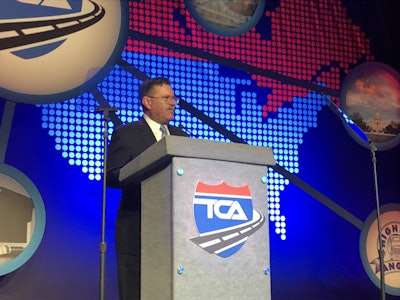
After 2018’s electronic logging device mandate ushered in a new era of visibility of hours-of-service compliance, 2019 will be a time of transition regarding the use and enforcement of ELDs and potential changes to HOS regulations, said Federal Motor Carrier Safety Administration Administrator Raymond Martinez during an address at the 81st Annual Truckload Carriers Association Convention in Las Vegas.
Martinez highlighted some positive enforcement trends since the ELD -related out-of-service criteria took effect last April that are reducing the number of drivers exceeding hours of service, reducing driver fatigue and saving lives. Preliminary data shows less than 1 percent of all driver inspections have resulted in a driver being cited for operating without a required ELD or grandfathered AOBRD. Additionally, HOS violations decreased by 52 percent in the last year.
“These are steps in the right direction,” said Martinez. “We understand industry is the one that is responsible for the successes here. Where there has been confusion sometimes, where there has been uncertainty, that has been mirrored on the enforcement side. This is a time of transition. It is important that the federal government, state partners on the enforcement side and the industry to make sure we work through all this in 2019 as we transition from AOBRDs to ELDs by December 16, 2019.”
Martinez noted the transition to ELDs has helped the agency take a closer look at HOS reform.
“[The ELD mandate] really put a spotlight on something that hasn’t been looked at in over 15 years,” said Martinez. “The data generated by ELDs highlights areas of current HOS regulations where adjustments or improvements may be needed. Commerce has changed, technology has changed, and your business has changed in that time.”
Martinez said the advanced notice of proposed rulemaking FMCSA put forth generated 5,200 comments on hot-button HOS issues including short-haul provisions, HOS exceptions for adverse driving conditions and the 30-minute rest break provision and the rule requiring drivers to spend eight consecutive hours in a sleeper berth.
“We continue to evaluate comments and are very close to concluding our evaluation and deciding whether we can move forward with an NPRM that would provide definitive text,” said Martinez.
“As we continue this work, we want to maintain safety while keeping uniform rules as much as possible for motor carriers and drivers wherever we can,” he added. “Uncertainty is not good for the industry and not good for the enforcement community.”
During his first year as administrator, Martinez said FMCSA has strived to make it a year of engagement to listen to all stakeholders. “I think that too often there is the notion that Washington isn’t listening,” he said. “That is certainly the perception I got my first few weeks on the job. There was a disconnect between our agency and the community we regulate. That’s not good as it undermines our mission.”
Martinez added that more laws and regulations from both the federal and state levels don’t necessarily translate to greater safety. “[Safety improvement] happens because the culture of safety you all have in your companies down to the safety director and driver level,” he said. “We understand that, so I think its critically important that we work together in a collaborative fashion to move that needle forward.”
Martinez also encouraged carriers to participate in FMCSA’s crash preventability demonstration program that it initiated last summer. The program allows carriers and drivers to have eight types of crashes reviewed if the driver clearly couldn’t have prevented the crash. “While the not preventable crash determinations currently won’t be removed from Safety Measurement System, the review of the crash and the determination will be noted and the carrier will be provided with an alternative SMS measurement and percentile so you can compare,” he said.
“I’m trying to make sure that we have enough data to move forward and build it out. When this pilot concludes in late summer, I’d like to make it permanent and include the removal of incorrect adverse determinations from the SMS. Not just because that’s beneficial for the carrier but because that’s what is good for FMCSA as well. We don’t want bad data that skews the larger information that we are after.”
Martinez also touched on FMCSA’s upcoming drug & alcohol clearinghouse final rule that takes effect in January 2020. “Ensuring safe CMV operations also means making sure both new and experienced drivers are drug- and alcohol-free,” he said. “The Drug and Alcohol Clearinghouse can move us one step closer to that goal… It will improve driver safety by identifying CMV drivers that have committed drug or alcohol violations that would make them ineligible from returning to duty to operate CMVs.”











